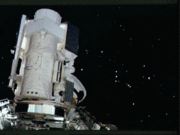Wisconsin Ultraviolet Photo-Polarimeter Experiment
The Wisconsin Ultraviolet Photo-Polarimeter Experiment WUPPE was one of three ultraviolet telescopes on the ASTRO-1 mission flown on the space shuttle Columbia during 2-10 December, 1990. 98 observations of 75 targets were obtained. The same three instruments were later flown on the space shuttle Endeavour from 3-17 March, 1995, as part of the ASTRO-2 mission. During the longer ASTRO-2 mission, 369 observations of 254 targets were obtained.
Most of the light we encounter every day is a chaotic mixture of light waves vibrating in all directions. Such a combination is known as unpolarized light. However, if the light - or other type of electromagnetic energy - passes through certain materials or is reflected, the waves will tend to vibrate more in one direction and the light is said to be polarized. You can observe polarized light by looking through a pair of polarizing sunglasses at the brightness of the blue sky about 90 degrees from the Sun. As you rotate the glasses, the brightness of the sky will vary because the light has been polarized by being reflected in the atmosphere.
By determining the amount and direction of polarization and how these change with wavelength, one can learn about what causes the energy to become polarized. By using polarimetry (the study of polarization), scientists can learn a great deal about the object being observed and the space between that object and Earth.
WUPPE consists of a telescope with a 50-centimeter (20-inch) mirror to reflect ultraviolet light to a spectropolarimeter, which splits the beam of radiation entering the telescope into two beams with perpendicular planes of polarization; the beams are then passed through a spectrometer and focused on separate array detectors. This results in a measurement of the degree and direction of polarization at many different wavelengths. Before the development and flight of this instrument on the Astro-1 mission, virtually no such UV data existed because of the difficulty in obtaining these measurements above the Earth's atmosphere with the degree of accuracy required for astronomical observations.
During the ASTRO-1 mission (launch GMT 1990/336/06:49:01) and the ASTRO-2 mission (launch GMT 1995/061/06:38:13), WUPPE obtained spectropolarimetry of a variety of astronomical objects, including distant stars to study the interstellar medium , hot stars, stars with circumstellar material, interacting binaries, novae, solar system objects, and active galaxies. The data gathered have allowed astronomers to refine theories and develop a better understanding of the universe. WUPPE paves the way for future instrumentation and research using spectropolarimetry.
